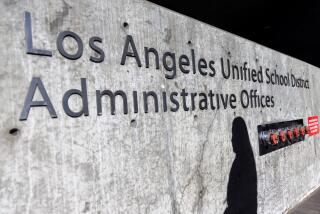ORANGE : Educators Tutored on the ‘At-Risk’
- Share via
Taking a small pocket mirror in one hand and a razor blade in the other, Sgt. Bump Willis taught Orange Unified School District teachers how to chop up a rock of cocaine.
Then, holding a small, plastic bag filled with semi-clear pebbles, the Garden Grove undercover officer displayed $10,000 worth of “ice,” a methamphetamine.
It was a lesson on drugs and drug paraphernalia, one of 32 workshops offered at Canyon High School in Anaheim Hills on Monday as part of a district conference on “at-risk” students. The workshops on gangs, dysfunctional families, steroids, alcohol, student depression and other topics drew about 800 participants, including Orange Unified School District teachers, classified employees, parents, and teachers and law enforcement officials from other cities.
The conference launched a yearlong program to help train teachers on how to recognize and help at-risk students--those prone to substance abuse, joining gangs, teen pregnancy, dropping out of school and other problems.
The training sessions are funded through a $177,467 federal grant, the largest awarded to Orange Unified in recent memory, according to Gayle Wayne, staff development coordinator who wrote the grant. A second conference is scheduled for February.
One goal of the conference was to encourage teachers to draw on parents, community organizations, and law enforcement officials to help solve the sometimes overwhelming problems that are spilling into the classroom, said Vicki James, coordinator of the district’s Drug, Alcohol and Tobacco Education (DATE) office.
“We’re busy mobilizing community and law enforcement officials,” she said. “Education has always been in its own sphere and it’s isolated. Bringing (officials) into the schools and breaking down our own walls is definitely new.”
Bill Beacham, executive director of the Center for Drug-Free Communities in Laguna Beach, said the Orange Unified conference was a strong first step in helping at-risk children.
“This is like really putting your community into action,” he added.
Tim Allen, a lecturer and author on topics relating to adolescents and families, held a seminar called “Taking the Risk Out of At-Risk Kids” that offered tips on how to recognize potentially troubled students and suggestions on how to reach them.
Rick Rowland, who began his first year of full-time teaching at Villa Park High this fall, said Allen’s session helped him focus on positive possibilities for his classroom.
“Last week I had a little bit of a bad taste in my mouth with some of my kids not doing their work,” Rowland said. “This class reminded me (that) I have to look at each of them as individuals.”
About 25% of all students come from dysfunctional families and could be called “at-risk,” Allen said. But teachers need to be reminded that they are not “a mini-sociologist or mini-narcotics agent,” he said.
Instead, teachers should focus on providing “a safe, secure, dependable environment that has love, care and concern in it so that kids know there is at least one place they can find that. Then, regardless of what’s going on at home, they’ll have some degree of success in the classroom.”
More to Read
Sign up for Essential California
The most important California stories and recommendations in your inbox every morning.
You may occasionally receive promotional content from the Los Angeles Times.













